Health Leadership Assignment: Quality, Safety, and Risk Management
VerifiedAdded on 2022/09/17
|9
|2020
|24
Homework Assignment
AI Summary
This assignment addresses key concepts in healthcare quality and leadership. It begins by defining healthcare quality and explaining the principles of Total Quality Management (TQM), including customer focus, strategic planning, continuous improvement, teamwork, process management, and quality assurance. The solution then delves into patient safety, differentiating it from general healthcare safety and discussing risk management approaches and tools like Root Cause Analysis and risk score calculation. Finally, the assignment explores safety culture, defining it and outlining measurement tools such as the Safety Attitudes Questionnaire and the Hospital Survey on Patient Safety Culture. The significance of a poor safety culture for healthcare professionals and patients is also highlighted. The provided solution offers a comprehensive overview of these critical topics.
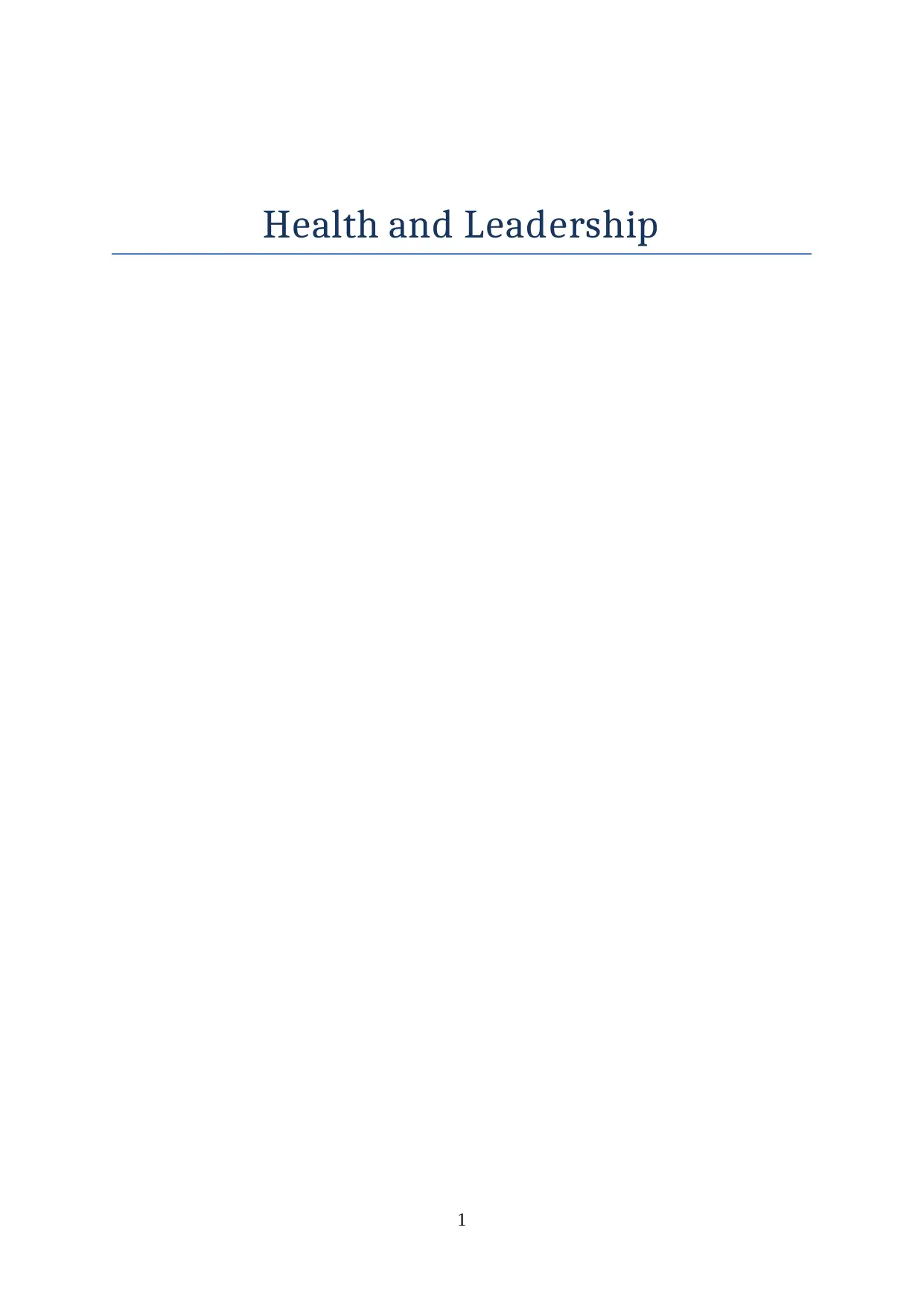
Health and Leadership
1
1
Paraphrase This Document
Need a fresh take? Get an instant paraphrase of this document with our AI Paraphraser

Table of Contents
Answer 1 – Quality and TQM....................................................................................................3
Answer 2 – Patient safety and risk.............................................................................................5
Answer 3 – Safety culture and measurement.............................................................................6
References..................................................................................................................................8
2
Answer 1 – Quality and TQM....................................................................................................3
Answer 2 – Patient safety and risk.............................................................................................5
Answer 3 – Safety culture and measurement.............................................................................6
References..................................................................................................................................8
2
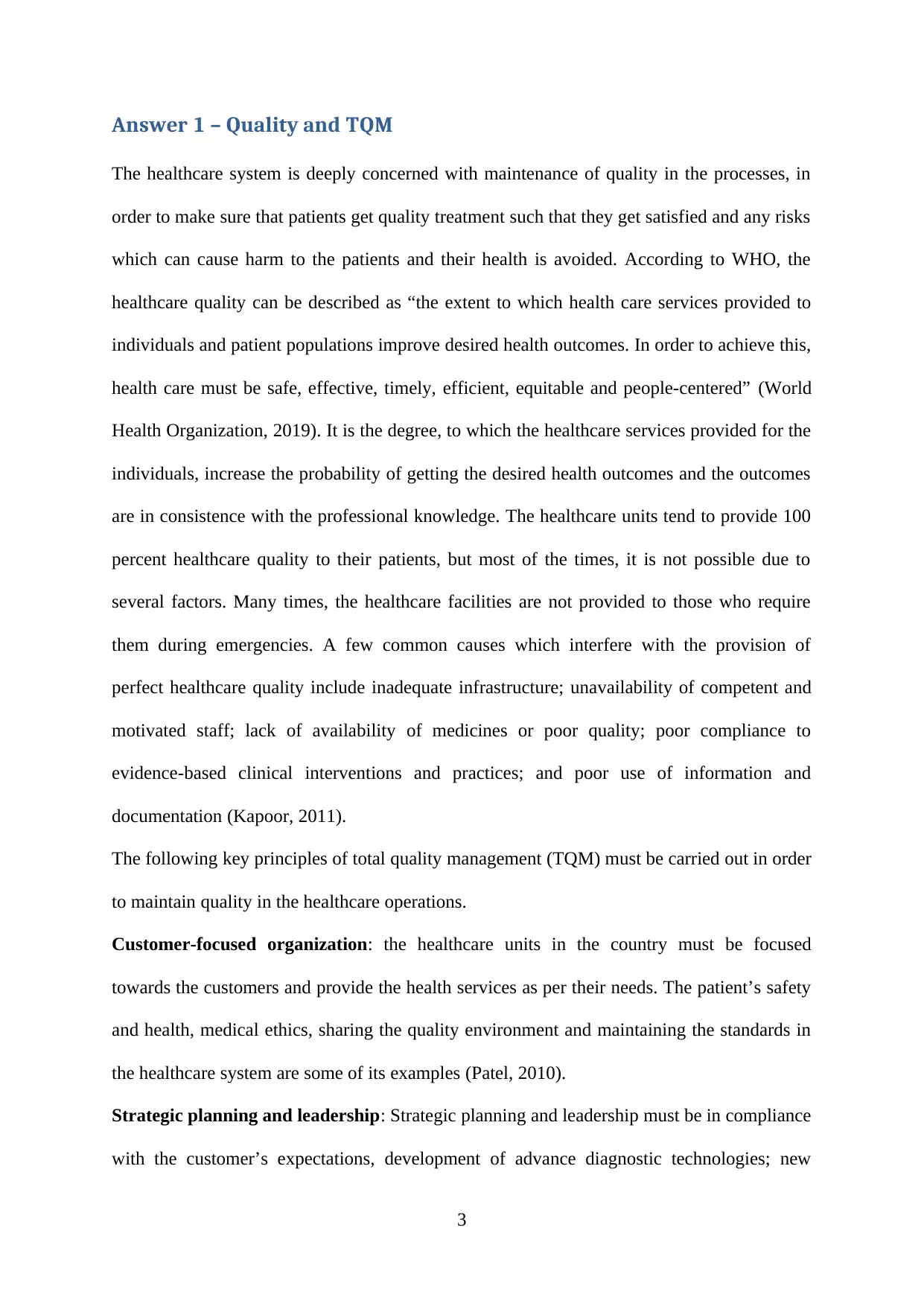
Answer 1 – Quality and TQM
The healthcare system is deeply concerned with maintenance of quality in the processes, in
order to make sure that patients get quality treatment such that they get satisfied and any risks
which can cause harm to the patients and their health is avoided. According to WHO, the
healthcare quality can be described as “the extent to which health care services provided to
individuals and patient populations improve desired health outcomes. In order to achieve this,
health care must be safe, effective, timely, efficient, equitable and people-centered” (World
Health Organization, 2019). It is the degree, to which the healthcare services provided for the
individuals, increase the probability of getting the desired health outcomes and the outcomes
are in consistence with the professional knowledge. The healthcare units tend to provide 100
percent healthcare quality to their patients, but most of the times, it is not possible due to
several factors. Many times, the healthcare facilities are not provided to those who require
them during emergencies. A few common causes which interfere with the provision of
perfect healthcare quality include inadequate infrastructure; unavailability of competent and
motivated staff; lack of availability of medicines or poor quality; poor compliance to
evidence-based clinical interventions and practices; and poor use of information and
documentation (Kapoor, 2011).
The following key principles of total quality management (TQM) must be carried out in order
to maintain quality in the healthcare operations.
Customer-focused organization: the healthcare units in the country must be focused
towards the customers and provide the health services as per their needs. The patient’s safety
and health, medical ethics, sharing the quality environment and maintaining the standards in
the healthcare system are some of its examples (Patel, 2010).
Strategic planning and leadership: Strategic planning and leadership must be in compliance
with the customer’s expectations, development of advance diagnostic technologies; new
3
The healthcare system is deeply concerned with maintenance of quality in the processes, in
order to make sure that patients get quality treatment such that they get satisfied and any risks
which can cause harm to the patients and their health is avoided. According to WHO, the
healthcare quality can be described as “the extent to which health care services provided to
individuals and patient populations improve desired health outcomes. In order to achieve this,
health care must be safe, effective, timely, efficient, equitable and people-centered” (World
Health Organization, 2019). It is the degree, to which the healthcare services provided for the
individuals, increase the probability of getting the desired health outcomes and the outcomes
are in consistence with the professional knowledge. The healthcare units tend to provide 100
percent healthcare quality to their patients, but most of the times, it is not possible due to
several factors. Many times, the healthcare facilities are not provided to those who require
them during emergencies. A few common causes which interfere with the provision of
perfect healthcare quality include inadequate infrastructure; unavailability of competent and
motivated staff; lack of availability of medicines or poor quality; poor compliance to
evidence-based clinical interventions and practices; and poor use of information and
documentation (Kapoor, 2011).
The following key principles of total quality management (TQM) must be carried out in order
to maintain quality in the healthcare operations.
Customer-focused organization: the healthcare units in the country must be focused
towards the customers and provide the health services as per their needs. The patient’s safety
and health, medical ethics, sharing the quality environment and maintaining the standards in
the healthcare system are some of its examples (Patel, 2010).
Strategic planning and leadership: Strategic planning and leadership must be in compliance
with the customer’s expectations, development of advance diagnostic technologies; new
3
⊘ This is a preview!⊘
Do you want full access?
Subscribe today to unlock all pages.

Trusted by 1+ million students worldwide
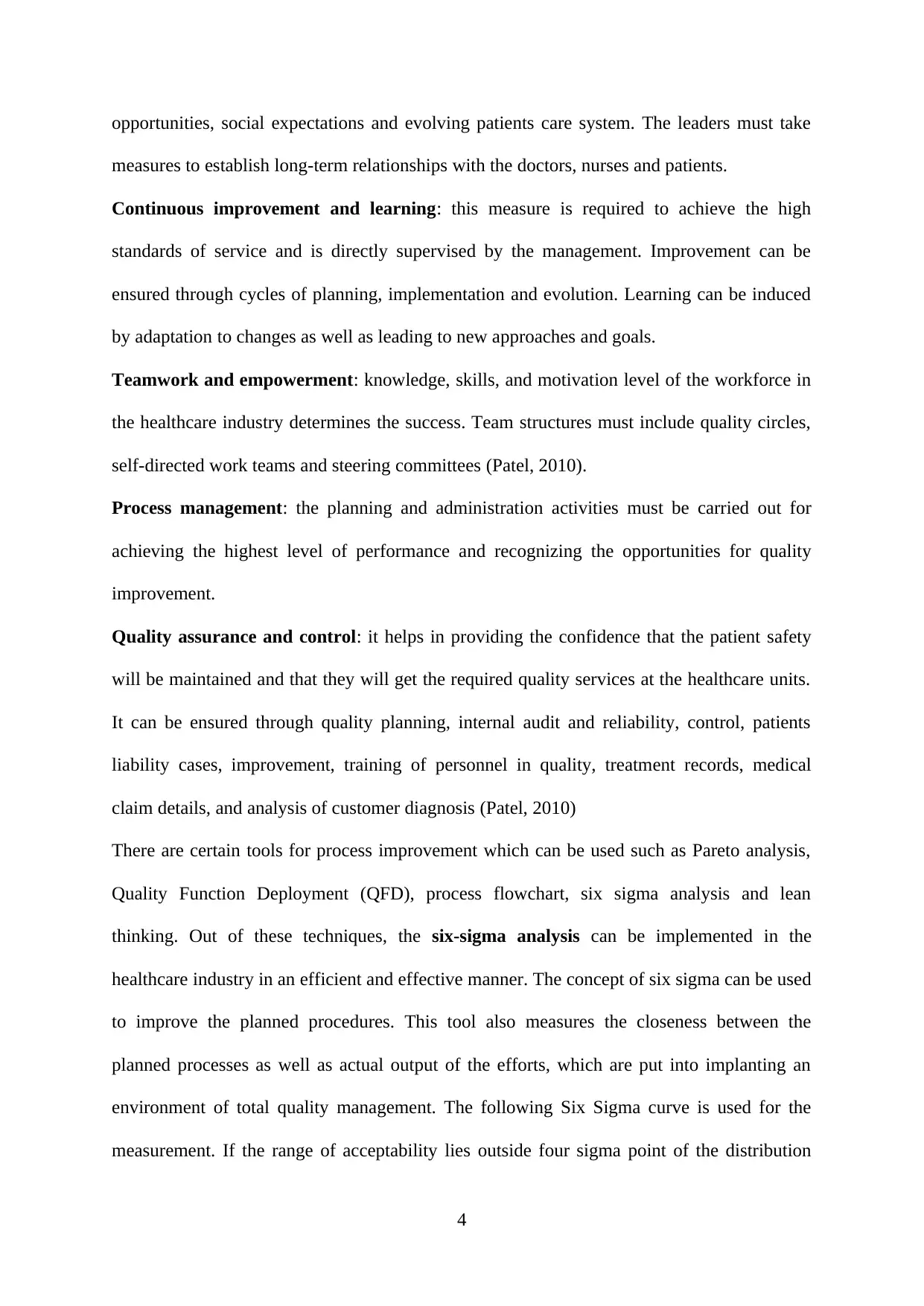
opportunities, social expectations and evolving patients care system. The leaders must take
measures to establish long-term relationships with the doctors, nurses and patients.
Continuous improvement and learning: this measure is required to achieve the high
standards of service and is directly supervised by the management. Improvement can be
ensured through cycles of planning, implementation and evolution. Learning can be induced
by adaptation to changes as well as leading to new approaches and goals.
Teamwork and empowerment: knowledge, skills, and motivation level of the workforce in
the healthcare industry determines the success. Team structures must include quality circles,
self-directed work teams and steering committees (Patel, 2010).
Process management: the planning and administration activities must be carried out for
achieving the highest level of performance and recognizing the opportunities for quality
improvement.
Quality assurance and control: it helps in providing the confidence that the patient safety
will be maintained and that they will get the required quality services at the healthcare units.
It can be ensured through quality planning, internal audit and reliability, control, patients
liability cases, improvement, training of personnel in quality, treatment records, medical
claim details, and analysis of customer diagnosis (Patel, 2010)
There are certain tools for process improvement which can be used such as Pareto analysis,
Quality Function Deployment (QFD), process flowchart, six sigma analysis and lean
thinking. Out of these techniques, the six-sigma analysis can be implemented in the
healthcare industry in an efficient and effective manner. The concept of six sigma can be used
to improve the planned procedures. This tool also measures the closeness between the
planned processes as well as actual output of the efforts, which are put into implanting an
environment of total quality management. The following Six Sigma curve is used for the
measurement. If the range of acceptability lies outside four sigma point of the distribution
4
measures to establish long-term relationships with the doctors, nurses and patients.
Continuous improvement and learning: this measure is required to achieve the high
standards of service and is directly supervised by the management. Improvement can be
ensured through cycles of planning, implementation and evolution. Learning can be induced
by adaptation to changes as well as leading to new approaches and goals.
Teamwork and empowerment: knowledge, skills, and motivation level of the workforce in
the healthcare industry determines the success. Team structures must include quality circles,
self-directed work teams and steering committees (Patel, 2010).
Process management: the planning and administration activities must be carried out for
achieving the highest level of performance and recognizing the opportunities for quality
improvement.
Quality assurance and control: it helps in providing the confidence that the patient safety
will be maintained and that they will get the required quality services at the healthcare units.
It can be ensured through quality planning, internal audit and reliability, control, patients
liability cases, improvement, training of personnel in quality, treatment records, medical
claim details, and analysis of customer diagnosis (Patel, 2010)
There are certain tools for process improvement which can be used such as Pareto analysis,
Quality Function Deployment (QFD), process flowchart, six sigma analysis and lean
thinking. Out of these techniques, the six-sigma analysis can be implemented in the
healthcare industry in an efficient and effective manner. The concept of six sigma can be used
to improve the planned procedures. This tool also measures the closeness between the
planned processes as well as actual output of the efforts, which are put into implanting an
environment of total quality management. The following Six Sigma curve is used for the
measurement. If the range of acceptability lies outside four sigma point of the distribution
4
Paraphrase This Document
Need a fresh take? Get an instant paraphrase of this document with our AI Paraphraser
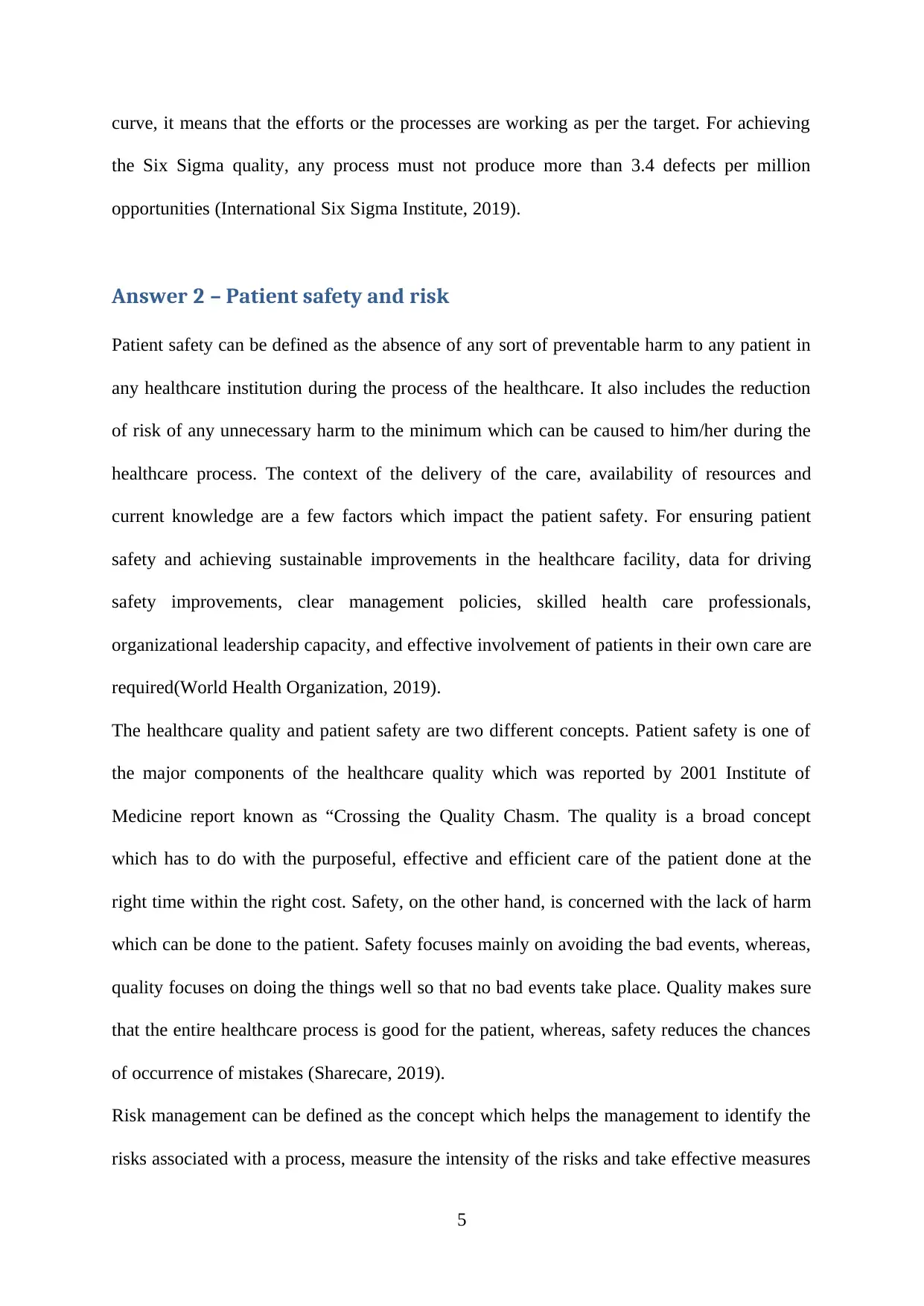
curve, it means that the efforts or the processes are working as per the target. For achieving
the Six Sigma quality, any process must not produce more than 3.4 defects per million
opportunities (International Six Sigma Institute, 2019).
Answer 2 – Patient safety and risk
Patient safety can be defined as the absence of any sort of preventable harm to any patient in
any healthcare institution during the process of the healthcare. It also includes the reduction
of risk of any unnecessary harm to the minimum which can be caused to him/her during the
healthcare process. The context of the delivery of the care, availability of resources and
current knowledge are a few factors which impact the patient safety. For ensuring patient
safety and achieving sustainable improvements in the healthcare facility, data for driving
safety improvements, clear management policies, skilled health care professionals,
organizational leadership capacity, and effective involvement of patients in their own care are
required(World Health Organization, 2019).
The healthcare quality and patient safety are two different concepts. Patient safety is one of
the major components of the healthcare quality which was reported by 2001 Institute of
Medicine report known as “Crossing the Quality Chasm. The quality is a broad concept
which has to do with the purposeful, effective and efficient care of the patient done at the
right time within the right cost. Safety, on the other hand, is concerned with the lack of harm
which can be done to the patient. Safety focuses mainly on avoiding the bad events, whereas,
quality focuses on doing the things well so that no bad events take place. Quality makes sure
that the entire healthcare process is good for the patient, whereas, safety reduces the chances
of occurrence of mistakes (Sharecare, 2019).
Risk management can be defined as the concept which helps the management to identify the
risks associated with a process, measure the intensity of the risks and take effective measures
5
the Six Sigma quality, any process must not produce more than 3.4 defects per million
opportunities (International Six Sigma Institute, 2019).
Answer 2 – Patient safety and risk
Patient safety can be defined as the absence of any sort of preventable harm to any patient in
any healthcare institution during the process of the healthcare. It also includes the reduction
of risk of any unnecessary harm to the minimum which can be caused to him/her during the
healthcare process. The context of the delivery of the care, availability of resources and
current knowledge are a few factors which impact the patient safety. For ensuring patient
safety and achieving sustainable improvements in the healthcare facility, data for driving
safety improvements, clear management policies, skilled health care professionals,
organizational leadership capacity, and effective involvement of patients in their own care are
required(World Health Organization, 2019).
The healthcare quality and patient safety are two different concepts. Patient safety is one of
the major components of the healthcare quality which was reported by 2001 Institute of
Medicine report known as “Crossing the Quality Chasm. The quality is a broad concept
which has to do with the purposeful, effective and efficient care of the patient done at the
right time within the right cost. Safety, on the other hand, is concerned with the lack of harm
which can be done to the patient. Safety focuses mainly on avoiding the bad events, whereas,
quality focuses on doing the things well so that no bad events take place. Quality makes sure
that the entire healthcare process is good for the patient, whereas, safety reduces the chances
of occurrence of mistakes (Sharecare, 2019).
Risk management can be defined as the concept which helps the management to identify the
risks associated with a process, measure the intensity of the risks and take effective measures
5
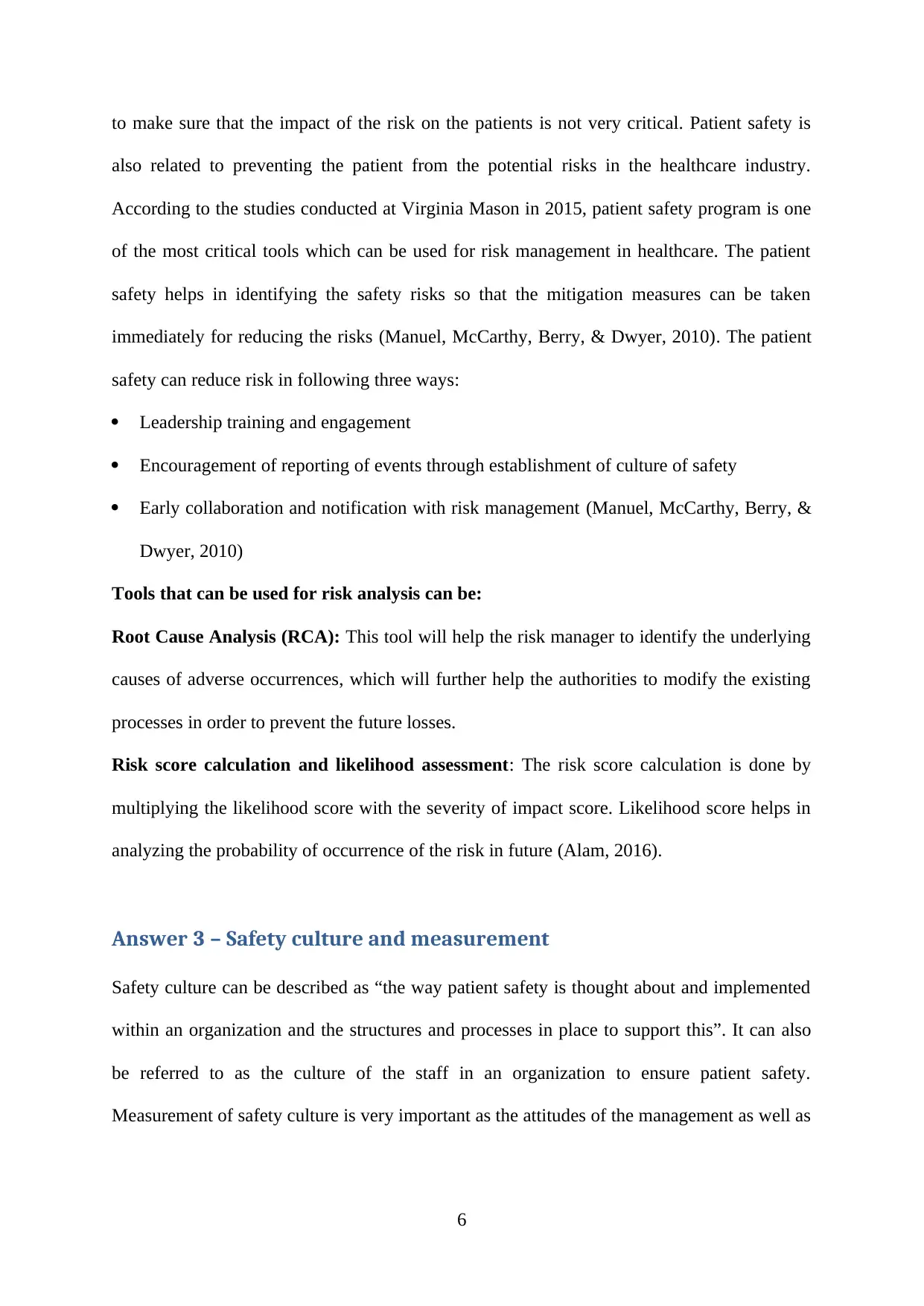
to make sure that the impact of the risk on the patients is not very critical. Patient safety is
also related to preventing the patient from the potential risks in the healthcare industry.
According to the studies conducted at Virginia Mason in 2015, patient safety program is one
of the most critical tools which can be used for risk management in healthcare. The patient
safety helps in identifying the safety risks so that the mitigation measures can be taken
immediately for reducing the risks (Manuel, McCarthy, Berry, & Dwyer, 2010). The patient
safety can reduce risk in following three ways:
Leadership training and engagement
Encouragement of reporting of events through establishment of culture of safety
Early collaboration and notification with risk management (Manuel, McCarthy, Berry, &
Dwyer, 2010)
Tools that can be used for risk analysis can be:
Root Cause Analysis (RCA): This tool will help the risk manager to identify the underlying
causes of adverse occurrences, which will further help the authorities to modify the existing
processes in order to prevent the future losses.
Risk score calculation and likelihood assessment: The risk score calculation is done by
multiplying the likelihood score with the severity of impact score. Likelihood score helps in
analyzing the probability of occurrence of the risk in future (Alam, 2016).
Answer 3 – Safety culture and measurement
Safety culture can be described as “the way patient safety is thought about and implemented
within an organization and the structures and processes in place to support this”. It can also
be referred to as the culture of the staff in an organization to ensure patient safety.
Measurement of safety culture is very important as the attitudes of the management as well as
6
also related to preventing the patient from the potential risks in the healthcare industry.
According to the studies conducted at Virginia Mason in 2015, patient safety program is one
of the most critical tools which can be used for risk management in healthcare. The patient
safety helps in identifying the safety risks so that the mitigation measures can be taken
immediately for reducing the risks (Manuel, McCarthy, Berry, & Dwyer, 2010). The patient
safety can reduce risk in following three ways:
Leadership training and engagement
Encouragement of reporting of events through establishment of culture of safety
Early collaboration and notification with risk management (Manuel, McCarthy, Berry, &
Dwyer, 2010)
Tools that can be used for risk analysis can be:
Root Cause Analysis (RCA): This tool will help the risk manager to identify the underlying
causes of adverse occurrences, which will further help the authorities to modify the existing
processes in order to prevent the future losses.
Risk score calculation and likelihood assessment: The risk score calculation is done by
multiplying the likelihood score with the severity of impact score. Likelihood score helps in
analyzing the probability of occurrence of the risk in future (Alam, 2016).
Answer 3 – Safety culture and measurement
Safety culture can be described as “the way patient safety is thought about and implemented
within an organization and the structures and processes in place to support this”. It can also
be referred to as the culture of the staff in an organization to ensure patient safety.
Measurement of safety culture is very important as the attitudes of the management as well as
6
⊘ This is a preview!⊘
Do you want full access?
Subscribe today to unlock all pages.

Trusted by 1+ million students worldwide
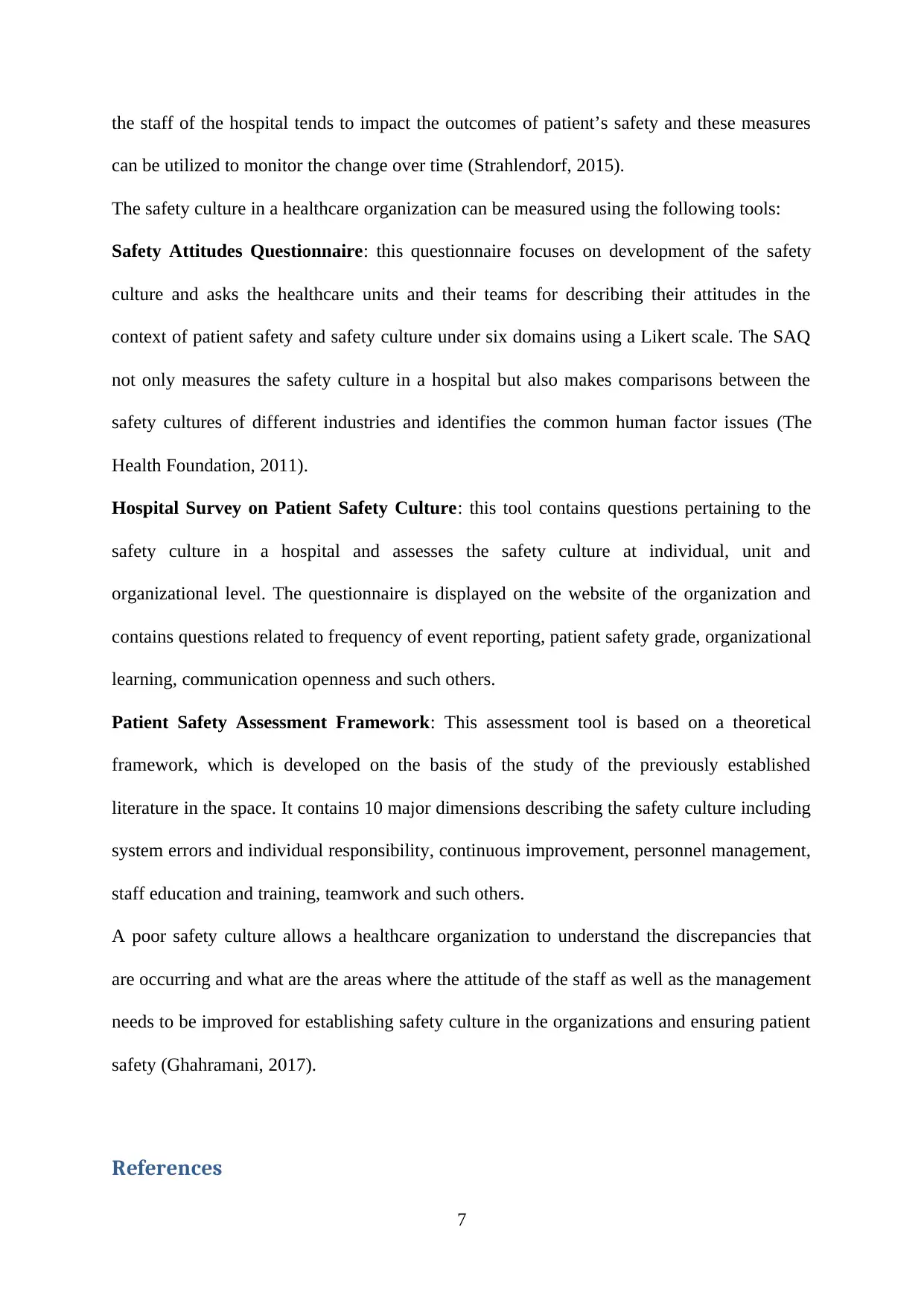
the staff of the hospital tends to impact the outcomes of patient’s safety and these measures
can be utilized to monitor the change over time (Strahlendorf, 2015).
The safety culture in a healthcare organization can be measured using the following tools:
Safety Attitudes Questionnaire: this questionnaire focuses on development of the safety
culture and asks the healthcare units and their teams for describing their attitudes in the
context of patient safety and safety culture under six domains using a Likert scale. The SAQ
not only measures the safety culture in a hospital but also makes comparisons between the
safety cultures of different industries and identifies the common human factor issues (The
Health Foundation, 2011).
Hospital Survey on Patient Safety Culture: this tool contains questions pertaining to the
safety culture in a hospital and assesses the safety culture at individual, unit and
organizational level. The questionnaire is displayed on the website of the organization and
contains questions related to frequency of event reporting, patient safety grade, organizational
learning, communication openness and such others.
Patient Safety Assessment Framework: This assessment tool is based on a theoretical
framework, which is developed on the basis of the study of the previously established
literature in the space. It contains 10 major dimensions describing the safety culture including
system errors and individual responsibility, continuous improvement, personnel management,
staff education and training, teamwork and such others.
A poor safety culture allows a healthcare organization to understand the discrepancies that
are occurring and what are the areas where the attitude of the staff as well as the management
needs to be improved for establishing safety culture in the organizations and ensuring patient
safety (Ghahramani, 2017).
References
7
can be utilized to monitor the change over time (Strahlendorf, 2015).
The safety culture in a healthcare organization can be measured using the following tools:
Safety Attitudes Questionnaire: this questionnaire focuses on development of the safety
culture and asks the healthcare units and their teams for describing their attitudes in the
context of patient safety and safety culture under six domains using a Likert scale. The SAQ
not only measures the safety culture in a hospital but also makes comparisons between the
safety cultures of different industries and identifies the common human factor issues (The
Health Foundation, 2011).
Hospital Survey on Patient Safety Culture: this tool contains questions pertaining to the
safety culture in a hospital and assesses the safety culture at individual, unit and
organizational level. The questionnaire is displayed on the website of the organization and
contains questions related to frequency of event reporting, patient safety grade, organizational
learning, communication openness and such others.
Patient Safety Assessment Framework: This assessment tool is based on a theoretical
framework, which is developed on the basis of the study of the previously established
literature in the space. It contains 10 major dimensions describing the safety culture including
system errors and individual responsibility, continuous improvement, personnel management,
staff education and training, teamwork and such others.
A poor safety culture allows a healthcare organization to understand the discrepancies that
are occurring and what are the areas where the attitude of the staff as well as the management
needs to be improved for establishing safety culture in the organizations and ensuring patient
safety (Ghahramani, 2017).
References
7
Paraphrase This Document
Need a fresh take? Get an instant paraphrase of this document with our AI Paraphraser
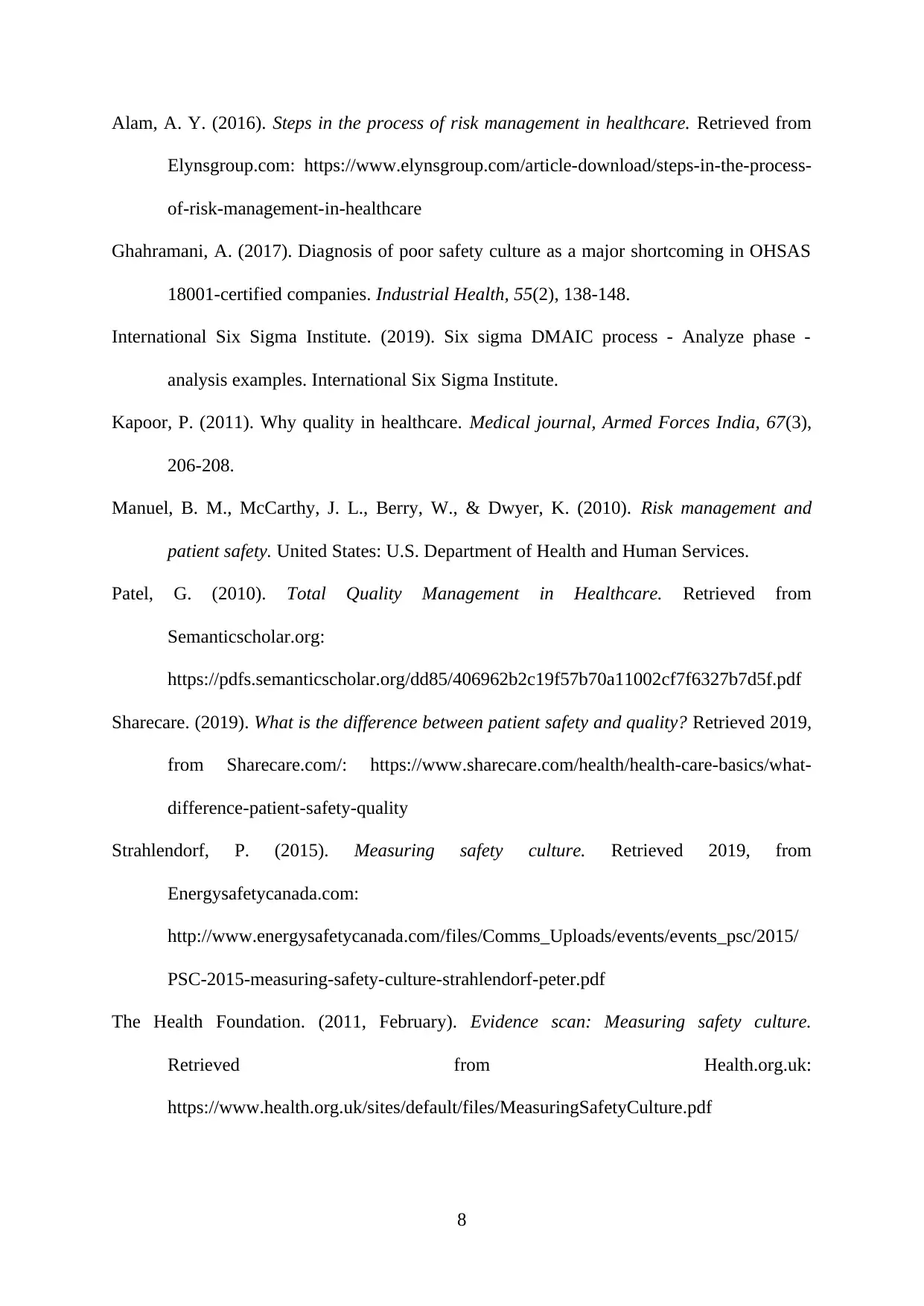
Alam, A. Y. (2016). Steps in the process of risk management in healthcare. Retrieved from
Elynsgroup.com: https://www.elynsgroup.com/article-download/steps-in-the-process-
of-risk-management-in-healthcare
Ghahramani, A. (2017). Diagnosis of poor safety culture as a major shortcoming in OHSAS
18001-certified companies. Industrial Health, 55(2), 138-148.
International Six Sigma Institute. (2019). Six sigma DMAIC process - Analyze phase -
analysis examples. International Six Sigma Institute.
Kapoor, P. (2011). Why quality in healthcare. Medical journal, Armed Forces India, 67(3),
206-208.
Manuel, B. M., McCarthy, J. L., Berry, W., & Dwyer, K. (2010). Risk management and
patient safety. United States: U.S. Department of Health and Human Services.
Patel, G. (2010). Total Quality Management in Healthcare. Retrieved from
Semanticscholar.org:
https://pdfs.semanticscholar.org/dd85/406962b2c19f57b70a11002cf7f6327b7d5f.pdf
Sharecare. (2019). What is the difference between patient safety and quality? Retrieved 2019,
from Sharecare.com/: https://www.sharecare.com/health/health-care-basics/what-
difference-patient-safety-quality
Strahlendorf, P. (2015). Measuring safety culture. Retrieved 2019, from
Energysafetycanada.com:
http://www.energysafetycanada.com/files/Comms_Uploads/events/events_psc/2015/
PSC-2015-measuring-safety-culture-strahlendorf-peter.pdf
The Health Foundation. (2011, February). Evidence scan: Measuring safety culture.
Retrieved from Health.org.uk:
https://www.health.org.uk/sites/default/files/MeasuringSafetyCulture.pdf
8
Elynsgroup.com: https://www.elynsgroup.com/article-download/steps-in-the-process-
of-risk-management-in-healthcare
Ghahramani, A. (2017). Diagnosis of poor safety culture as a major shortcoming in OHSAS
18001-certified companies. Industrial Health, 55(2), 138-148.
International Six Sigma Institute. (2019). Six sigma DMAIC process - Analyze phase -
analysis examples. International Six Sigma Institute.
Kapoor, P. (2011). Why quality in healthcare. Medical journal, Armed Forces India, 67(3),
206-208.
Manuel, B. M., McCarthy, J. L., Berry, W., & Dwyer, K. (2010). Risk management and
patient safety. United States: U.S. Department of Health and Human Services.
Patel, G. (2010). Total Quality Management in Healthcare. Retrieved from
Semanticscholar.org:
https://pdfs.semanticscholar.org/dd85/406962b2c19f57b70a11002cf7f6327b7d5f.pdf
Sharecare. (2019). What is the difference between patient safety and quality? Retrieved 2019,
from Sharecare.com/: https://www.sharecare.com/health/health-care-basics/what-
difference-patient-safety-quality
Strahlendorf, P. (2015). Measuring safety culture. Retrieved 2019, from
Energysafetycanada.com:
http://www.energysafetycanada.com/files/Comms_Uploads/events/events_psc/2015/
PSC-2015-measuring-safety-culture-strahlendorf-peter.pdf
The Health Foundation. (2011, February). Evidence scan: Measuring safety culture.
Retrieved from Health.org.uk:
https://www.health.org.uk/sites/default/files/MeasuringSafetyCulture.pdf
8
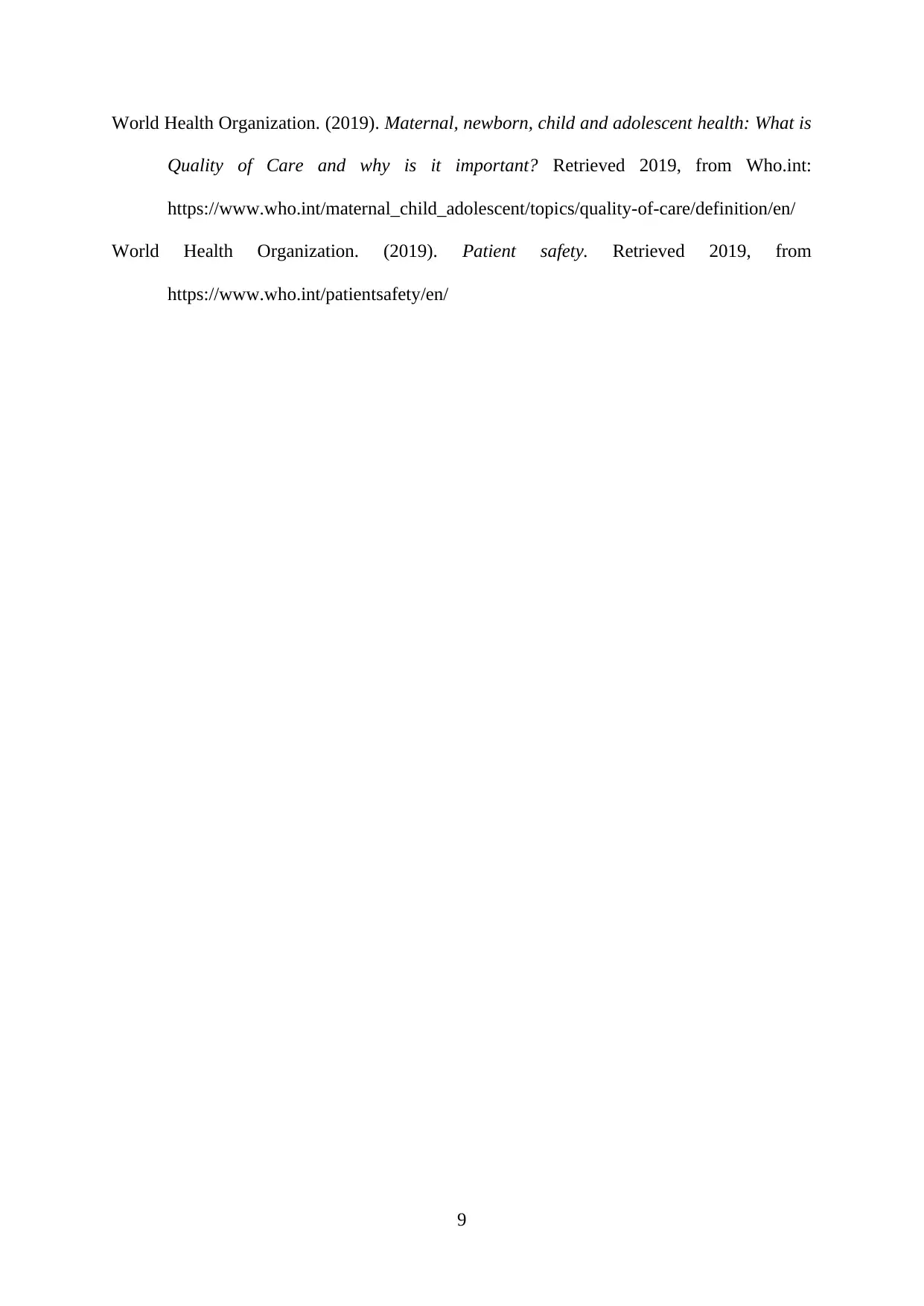
World Health Organization. (2019). Maternal, newborn, child and adolescent health: What is
Quality of Care and why is it important? Retrieved 2019, from Who.int:
https://www.who.int/maternal_child_adolescent/topics/quality-of-care/definition/en/
World Health Organization. (2019). Patient safety. Retrieved 2019, from
https://www.who.int/patientsafety/en/
9
Quality of Care and why is it important? Retrieved 2019, from Who.int:
https://www.who.int/maternal_child_adolescent/topics/quality-of-care/definition/en/
World Health Organization. (2019). Patient safety. Retrieved 2019, from
https://www.who.int/patientsafety/en/
9
⊘ This is a preview!⊘
Do you want full access?
Subscribe today to unlock all pages.

Trusted by 1+ million students worldwide
1 out of 9
Related Documents
Your All-in-One AI-Powered Toolkit for Academic Success.
+13062052269
info@desklib.com
Available 24*7 on WhatsApp / Email
![[object Object]](/_next/static/media/star-bottom.7253800d.svg)
Unlock your academic potential
Copyright © 2020–2025 A2Z Services. All Rights Reserved. Developed and managed by ZUCOL.



